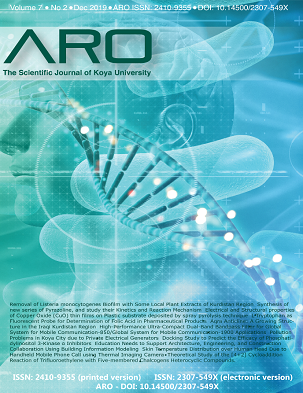Removal of Listeria monocytogenes Biofilm with Some Local Plant Extracts of Kurdistan Region
DOI:
https://doi.org/10.14500/aro.10385Keywords:
Biofilm, Eugenia caryophyllata, Listeria monocytogenes, Salix candida.Abstract
The results of removing or reducing biofilm were determined using subinhibitory concentrations (SICs) of some local plants in the flora of Kurdistan region of Iraq on biofilm production in Listeria monocytogenes. About 10–500 µg/ml of the plant extracts were used against growth and biofilm production in tissue culture plates which were measured spectroscopically. The SIC effects of each of Eugenia caryophyllata (Clove) and Rhus glabra (Sumac) have significantly affected on planktonic cells and reduced sessile cells or biofilm formation in L. monocytogenes. Remarkably, the data showed strong biofilm reduction under synergistically effect of the plant extract mixed with the antimicrobial agents in multidrugresistant L. monocytogenes. Whereas the SIC some of other plant extracts such as Salix candida and pomegranate (Punica granatum) have significantly enhanced biofilm expression in L. monocytogenes, but the use of these extracts synergistically with some antibiotics also resulted in inhibition of biofilm in comparison to merely use of either the extracts or antibiotics. The result of statistical analyses shows that P > 0.05. The results showed that the combination of plant extract with antibiotic together has more effect than using plant merely.Downloads
References
Bose, S., Khodke, M., Basak, S., and Malick, S.K., 2009. Detection of biofilm producing staphylococci: need of the hour. Journal of Clinical and Diagnostic Research, 3(6), pp.1915-1920.
Burmølle, J.S.W., Dhana R., Lars H.H., Søren J.S.M., and Staffan, K., 2006. Enhanced Biofilm formation and increased resistance to antimicrobial agents and bacterial invasion are caused by synergistic interactions in multi species biofilms. Journal of American Society for Microbiology Applied and Environmental Microbiology, 72(6), pp.3916-3923.
Djordjevic, D., Wiedmann, M., and Mclandsborough, L.A., 2002. Microtitre plate assay for assessment of Listeria monocytogenes biofilm formation. Applied and Environmental Microbiology, 68(6), pp.2950-2958.
Donlan, R.M., and Costerton, W., 2002. Biofilms: Survival mechanisms of clinically relevant microorganisms. Clinical microbiological Review, 15(2), pp.167-193.
Essawi, T., and Srour, M., 2000. Screening of some palestinian medicinal plants for antibacterial activity. Journal Ethnopharmacology, 70(3), pp.343-349.
García-Almendárez, B.E., Cann, I.K.O., Martin, S.E., Guerrerro-Legrreta, I., and Regalado, C., 2007. Effect of Lactococcus lactis UQ2 and its bacteriocin on Listeria monocytogenes biofilms. Food Control, 19, pp.670-680.
Giuseppe, B., Russo, P., Capozzi, V., Amodio, M.L., Giuseppe, S., and Luciano, B., 2013. Listeria monocytogenes, biofilm formation and fresh cut produce. Food and Environmental Sciences, pp.114-123.
Guarrera, P.M., 2005. Traditional phytotherapy in central Italy (Marche, Abruzzo, and Latium). Fitoterapia, 76(1), pp.1-25.
Hurlow, J., Couch, K., Laforet, K., Bolton, L., Metcalf, D., and Bowler, P., 2015. Clinical biofilms: A challenging frontier in wound care. Adv Wound Care, 4, pp.295-301.
Muhsin, J., Wisal, A., Saadia, A., Fazal, J., Muhammad, I., Muhammad, A.N., Tahir, H., Muhammad, A., Muhammad, R., and Muhammad, A.K., 2018. Bacterial biofilm and associated infections. Journal of the Chinese Medical Association, 81(1), pp.7-11.
National Committee for Clinical Laboratory Standards (NCCLS). 2000. Methods for Dilution Antimicrobial Susceptibility Tests for Bacteria that Grow Aerobically. National Committee for Clinical Laboratory Standards, Wayne, PA.
Ncube, N.S., Afolayan, A.J., and Okoh, A.I., 2008. Assessment techniques of antimicrobial properties of natural compounds of plant origin: Current methods and future trends. African Journal of Biotechnology, 7(12), pp.1797-1806.
Nyila, M.A., Leonard, C.M., Hussein, A.A., and Lall, N., 2012. Activity of South African medicinal plants against Listeria monocytogenes biofilms, and isolation of active compounds from Acacia karroo. South African Journal of Botany, 78, pp.220-227.
Nzeako, B.C., and Lawat, B.A., 2008. Comparative studies of antimycotic potential of thyme and clove oil extracts with antifungal antibiotics on Candida albicans. African Journal of Biotechnology, 7(1), pp.1612-1619.
Odey, M.O., Iwara, I.A., Udiba, U.U., Johnson, J.T., Inekwe, U.V., Asenye, M.E., and Victor, O., 2012. Preparation of plant extracts from indigenous medicinal plants. International Journal of Science and Technology, 1(12), pp.688-692.
Richard, J.L., and Morris, L.M., 2000. An Introduction to Mathematical Statistics and its Applications. 3rd ed. Prentice-Hall, New Jersey, p.282.
Sandasi, M., Leonard, C.M., and Viljoen, A.M., 2010. The in vitro antibiofilm activity of selected culinary herbs and medicinal plants against Listeria Monocytogenes. Letters in Applied Microbiology, 50(1), pp.30-5.
Srwa, A.M., 2014. Biofilm determination of Listeria monocytogenes that isolated from different sources. Journal of Life Science, 8(10), pp.1-5.
Srwa, A.M., and Shwan, K.R., 2017. Inhibition of biofilmi production in multi-drug resistant Klebsiella pneumonia by extract of some plants in the flora of Koya city. Proceedings ICNS Charmo Journal, 2, pp.60-67.
Downloads
Published
How to Cite
Issue
Section
License
Authors who choose to publish their work with Aro agree to the following terms:
-
Authors retain the copyright to their work and grant the journal the right of first publication. The work is simultaneously licensed under a Creative Commons Attribution License [CC BY-NC-SA 4.0]. This license allows others to share the work with an acknowledgement of the work's authorship and initial publication in this journal.
-
Authors have the freedom to enter into separate agreements for the non-exclusive distribution of the journal's published version of the work. This includes options such as posting it to an institutional repository or publishing it in a book, as long as proper acknowledgement is given to its initial publication in this journal.
-
Authors are encouraged to share and post their work online, including in institutional repositories or on their personal websites, both prior to and during the submission process. This practice can lead to productive exchanges and increase the visibility and citation of the published work.
By agreeing to these terms, authors acknowledge the importance of open access and the benefits it brings to the scholarly community.
Accepted 2019-08-10
Published 2019-12-10
















 ARO Journal is a scientific, peer-reviewed, periodical, and diamond OAJ that has no APC or ASC.
ARO Journal is a scientific, peer-reviewed, periodical, and diamond OAJ that has no APC or ASC.